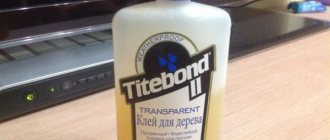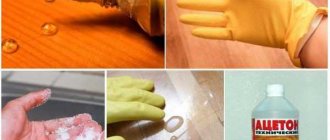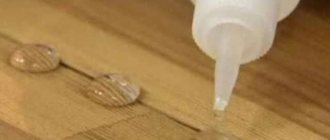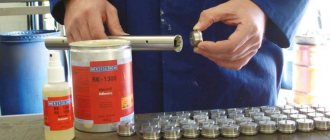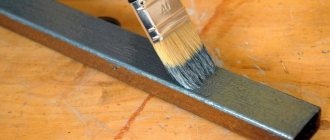Glass is quite common in human everyday life. This material is used in construction. Furniture and interior items are made from it. Sometimes situations arise when you need to connect glass parts or glue glass to some other material. You can solve this problem by arming yourself with special glue. Such a substance should connect the glass parts firmly and not reduce their transparency.
How to choose glue for glass
Glass has low adhesion ability. Therefore, joining such surfaces is difficult. The fragility of the material further complicates the task. To glue glass objects, you need a special substance that has certain qualities:
- High adhesion for connecting objects that experience significant mechanical stress in everyday life.
- Transparency so that the resulting joint becomes invisible. When connecting small parts, this quality is even more important than strength.
- Ability to dry in a short time.
- Increased thickness so that the final joint becomes elastic.
- Ability to withstand significant temperatures, as well as frost and heat.
- The ability to repel moisture when in a humid environment or when using products in atmospheric conditions.
- Environmentally friendly and safe for nature.
It is optimal to choose transparent products for work. They can easily neatly connect small parts of the decor. It is also worth considering the physical parameters: transparent compounds are suitable for combining smooth objects, but if the surface is corrugated, a stronger formula will be required. When it is necessary to connect parts of an aquarium, choose a product that does not contain antibacterial components and will not harm the fish. Durable compounds are chosen to connect painted surfaces.
Helpful Tips and Warnings
If decorative finishing work is required, use a special glass gluing agent. This composition is transparent, transmits light well, repels moisture and withstands temperature changes. After repair with this product, the seam on the product becomes invisible. In addition, this substance perfectly connects glass and metal elements.
Very often in everyday life you have to use superglue. If used carelessly, glue may spill onto furniture or...
If you need to connect parts of the aquarium together, choose a product that provides an elastic seam and muffles shocks. Otherwise, the slightest sharp sound or impact will cause the aquarium filled with water to split. Before connecting the parts of the future aquarium, they are treated with sealant so that the connection is strong and moisture-resistant.
To control the amount of adhesive in the joint area, it is applied with a brush. This will eliminate the need to cut off excess drug later.
Making glue at home
Special means for gluing glass surfaces are not always available. In this case, homemade mixtures will help:
- The simplest glue is made from a mixture of equal amounts of ash and bone glue. Before using this product, the parts must be warmed up.
- The glass parts are connected with a mixture of 1 part casein glue and 10 parts silicate glue.
- If you need to repair a small glass, garlic juice can replace regular glue.
- To join glass and wood, a mixture of wood glue and ash is used.
Large glass parts are glued together with a product that consists of the following components:
- 1 part beeswax;
- 5 parts drying oil;
- 10 parts rosin;
- 5 parts chalk;
- 2.5 parts cement.
First, combine all the components except cement and heat to a boil. After this, the heating is turned off and the mass is cooled to +50 degrees. Then cement is added to the total mass and mixed well.
Properties and applications of silicone adhesives and sealants
Silicone adhesives and sealants have become widespread due to a combination of qualities that other products in this group do not have. All qualities can be divided into two groups - general and seam properties.
General properties of silicone adhesives:
- The glue has such a consistency that, on the one hand, it does not spread when applied to the surface, and on the other hand, it fills nerves and small cavities well;
- Adhesives and sealants have high adhesion, thanks to which they stick to a wide variety of materials - glass, ceramics, metals and others. However, good gluing of plastics, as well as some porous materials, can only be achieved by using silicone adhesives with special additives, or by first applying primers (primer) to the surfaces of objects;
- Modern silicone adhesives are for the most part non-toxic and do not require compliance with any special safety regulations;
- The glue is very easy to use and does not require special skills to operate;
- Polymerization (hardening) of the glue occurs within two to three hours, complete curing occurs within 24 hours.
Seam properties of silicone adhesives and sealants:
- After polymerization, the seam becomes strong, but elastic - it can be subjected to bending, tensile, compressive and torsional loads without losing its strength properties. Some adhesives allow the seam to stretch up to 25% of its width;
- The seam is waterproof;
- The seam is resistant to ultraviolet radiation;
- The transparency of the seam does not decrease over time (only if the glue or sealant does not contain a large percentage of plasticizers and other additives);
- The joint retains its properties at temperatures from -40 to +200°C, high-temperature adhesives and sealants can withstand heating up to +375°C, many sealants retain their properties at very low temperatures down to -70°C;
- A seam may have antiseptic, fungicidal and other qualities - it all depends on the presence of various additives in the glue or sealant.
Thanks to all these qualities, silicone adhesives can be used to solve several problems at once:
- Bonding materials that are difficult for other adhesives;
- Use for sealing seams;
- Use as gaskets in various units and mechanisms.
Gluing. Silicone adhesive can be used for traditionally difficult-to-glue materials such as glass, ceramics, brick, metals and many others. But it can also be used to glue wood, some plastics, elastic polymers, etc. Silicone adhesives are suitable for repairing some parts in a car, for gluing aquariums, they are used in various hobbies, and simply for repairing various things at home.
Sealing of seams. Adhesives are used to seal seams between glass (as well as metal and plastic) elements - in a car, with the help of such glue, you can ensure reliable installation of headlights, sealing of hatches and fixed windows, etc. And sealants find the widest application in construction and finishing works.
Replacing gaskets. In essence, this is the same sealing, but it is performed in units, mechanisms and assemblies of various equipment. Silicone adhesive or sealant can act as a more reliable replacement for gaskets (or for repairing damaged gaskets) in various engine components, transmissions and other units. However, it is strictly forbidden to use these products in automatic transmissions, as silicone particles can get into the box, clog the oil channels and lead to other serious problems.
It is interesting to note that silicone adhesives and sealants, due to their wide temperature range, can be used for bonding or sealing seams in devices and mechanisms subject to extreme heating or cooling - in engines, heaters, refrigeration units, air conditioners (with caution), etc.
However, silicone adhesives and sealants have a number of features that should always be taken into account when using them. In particular, most adhesives are unable to reliably glue such types of polymers as polyethylene, fluoroplastic, polycarbonate, etc. To work with plastics, including PVC, special types of adhesives and sealants are used that have better adhesion to these types of surfaces.
Also, silicone adhesives and sealants are destroyed under the influence of certain substances, including gasoline, and some adhesives lose their quality when in contact with ethylene glycol (which is the main component of antifreezes such as antifreeze) and even with synthetic motor oils.
So before using silicone glue, you need to read its instructions for use, and also take into account the general recommendations given here. Only if used correctly will this adhesive or sealant work effectively and not create problems.
Surface preparation
Before gluing glass to glass or other material, the surfaces are cleaned of dust and dirt and degreased. Suitable products for this purpose include acetone, white spirit, medical alcohol, kerosene or solvent. You can remove grease from surfaces with special Bohle construction products.
Important! Household chemicals for cleaning glass or plumbing are not suitable for degreasing.
It is important to follow safety rules when cleaning the surface. To avoid poisoning by toxic fumes, work is carried out in a ventilated area. Rubber gloves are worn to protect hands. This precaution will protect the glass parts from sebum.
Then the parts to be connected are heated to remove condensation. It is optimal to heat the surfaces 30 degrees above room temperature. You can easily do this yourself with a regular hairdryer.
How to seal a crack in glass in doors and furniture
If the doors or pieces of furniture in your home have glass inserts, then you have probably encountered cracks in these glasses.
In this situation, you can do the following:
- If the crack is of an impressive size and is visible, then you can order a replacement element on the manufacturer’s website or from a company representative.
- If the first option is not suitable for you, then you can try to hide the crack: paint it over with varnish, then decorate the problem with professional paint or ornament.
- You can also use the methods described above to eliminate cracks in window glass.
Let your doors and furniture always fill your interior with aesthetics!
Bonding glass parts
After preparing the surface, the parts are checked by placing them next to each other so that there are no distortions or mismatches. If there are a lot of objects, you can fix them with any suitable devices. If the glass has cooled down during preparation, it is heated again.
The parts are connected in the following order:
- One of the parts is covered with an adhesive.
- Apply the second part and squeeze tightly for 2 minutes.
- The product is left until the glue is completely dry. The specific time depends on the type of adhesive.
- Cut off the excess protruding from the seam with a sharp blade.
- Wipe the resulting seam with glass cleaner.
Important! If polymer glue is used for joining, the product is placed under an ultraviolet lamp or in direct sunlight to dry the seam.
How much will it cost to change the screen on your phone?
With the cost of work, everything is simple; inexpensive service centers charge an average of 1000-2000 rubles for glass replacement for most phone models. The price may be higher if it is very difficult to change the glass for a particular phone model.
Interesting materials:
What is the time difference between Moscow and Khabarovsk? What is the time difference with South Korea? What is the time difference with Canada? What is a person's body temperature during sleep? What are the 5 best inventions of all time? What character traits make Pechorin a hero of his time? What wonders of the world have been created in our time? What films were made during the war? What verbs form the present tense? Which of the seven wonders of the world have survived to this day?
Gluing glass to metal
In this case, the technology for connecting surfaces differs from the previous version. To combine items with different properties, VERIFIX MV 750 or B 682-0 are suitable. They are characterized by high viscosity, so they are suitable for working with tempered, reinforced or ordinary glass.
Surface preparation is no different from the previous version. They are also cleared of paint, washed, dried and degreased. Then clear glass glue is applied to both surfaces to be joined. They are pressed tightly and pressed down. After this, the joint area is irradiated with an ultraviolet lamp for 20 seconds. After waiting a few minutes, ultraviolet irradiation is repeated. Now the exposure time is 5 minutes.
Cyanoacrylate
This clear glue is almost universal. It is capable of gluing glass to wood, metal or plastic. With its help, you can repair the desired item or apply decor. This adhesive composition has the following qualities:
- waterproof;
- highly adhesive;
- lasting;
- is able to ensure the tightness of any connections.
In terms of its strength characteristics, it surpasses many fastening joints and is considered “cold welding”.
Many transparent Moment adhesives are made with the addition of cyanoacrylates.
